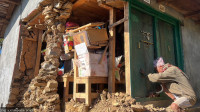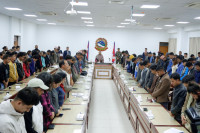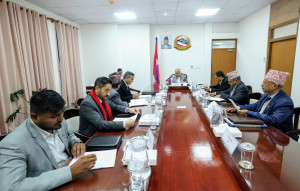Columns
Rise of nasal bleeding dengue
As monsoon approaches, the risk of a pathogenic dengue outbreak shouldn’t be underestimated.
Dr Sher Bahadur Pun
Last year, a 34-year-old man visited a hospital with complaints of nasal bleeding (epistaxis). The patient had a history of mild fever, body aches, pain behind the eyes, joint pain, nausea and skin rash. After laboratory confirmation, he was diagnosed with dengue infection. Surprisingly, several other medical practitioners also observed a significant increase in nasal bleeding cases in patients during the same time, suggesting a possible emerging trend or complication associated with dengue.
A sudden and unexpected rise in such cases has become a serious concern, as it is one of the key warning signs of severe dengue, which, if not identified and managed promptly, can even cost lives. This raises the question of whether dengue is becoming more severe in Nepal.
Over the past few years, the dengue virus has become increasingly infectious, virulent and aggressive in Nepal. Although now considered an endemic disease, the country has experienced cyclical dengue outbreaks at intervals of approximately two to three years. Kathmandu experienced its first major dengue outbreak in 2022, with at least 88 reported deaths and thousands of confirmed cases. This represented the largest outbreak ever recorded in a single city in Nepal since the virus was first reported in an individual in 2004.
However, based on my observation as a frontline doctor, nasal bleeding wasn’t common among patients with dengue in earlier outbreaks. It shows that the current clinical manifestation of dengue may be evolving, potentially indicating an increased pathogenicity of the virus compared to previous years. As monsoon approaches and the mosquito population rises in the community, the possibility of a larger and more pathogenic dengue outbreak should not be underestimated.
Symptoms of dengue include severe headache, pain behind the eyes, joint pain, nausea/vomiting and rash. Recently, diarrhoea has been frequently observed in patients with dengue in the country. The clinical progression can be classified into three stages: Classical dengue fever, dengue hemorrhagic fever and dengue shock syndrome. Before 2022, the majority of patients had classical symptoms. Nevertheless, there has been a noticeable shift in dengue in recent years, with an increasing proportion of cases advancing to the hemorrhagic form. To understand the underlying causes/reasons, proper investigations should be conducted.
Last year, many people continued with their daily activities despite being infected with the dengue virus, a phenomenon I referred to as “walking dengue”. Although the number of infected patients has risen in recent years, the concerned authorities and the general public haven’t taken preventive measures seriously. This lack of commitment and awareness is evident in the increasing number of “walking dengue” cases. Further, hundreds of people with symptoms similar to dengue do not even undergo testing for the virus. This challenges the government’s goal of achieving zero deaths from dengue.
Persistent vomiting, severe abdominal pain, bleeding from the nose, gums or other parts of the body and lethargy/restlessness are warning signs of dengue. These symptoms may appear during the “walking dengue” time period. At this stage, individuals should promptly visit the nearest hospital for a thorough evaluation to assess the risk of severe dengue. In addition to these symptoms, the accumulation of fluids in the abdomen or chest, a rapid decrease in platelet count, and an increase in liver size (exceeding 2 cm) are other indicators of the warning phase of dengue.
A few weeks ago, a relative of mine shared his experience following a dengue infection. He mentioned that after taking paracetamol to relieve severe body aches without any improvement, he resorted to taking Flexon tablets, despite medical advice against using such medication during dengue infection or outbreaks. In fact, many people in Nepal self-medicate by purchasing over-the-counter medications such as Flexon, a non-steroidal anti-inflammatory drug (NSAID) associated with contributing to complications like nasal bleeding. Many do not undergo diagnostic tests and remain unaware of the underlying cause of their fever/illness. Self-medication issues during dengue outbreaks, perhaps widespread in other South Asian countries, could contribute to a potential increase in the “bleeding epidemic” in the coming years. Moreover, shortages of paracetamol during dengue outbreaks in affected areas have forced many patients to resort to alternative medications such as Flexon.
Since 2022, no significant outbreak has occurred in Kathmandu, meaning the city could face its next major outbreak anytime. As Nepal continues to witness an increasing number of cases, with one of the prominent warning signs of severe dengue—nasal bleeding—our efforts should focus on disseminating awareness programmes through newspapers, TV, radio, podcasts and posters. Equally vital is studying and identifying the reasons behind clinical shifts. Such initiatives will be crucial in mitigating complications or deaths from dengue.




 20.12°C Kathmandu
20.12°C Kathmandu















